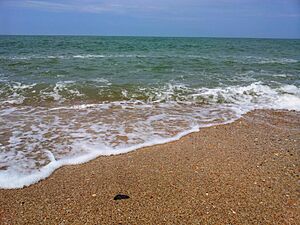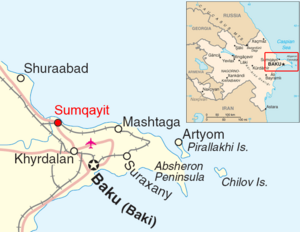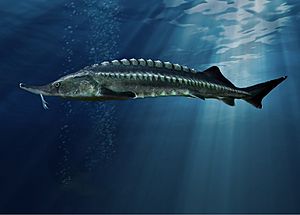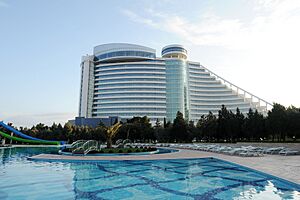Absheron Peninsula facts for kids
Quick facts for kids
Absheron Peninsula
|
|
|---|---|
 |
|
| Country | Azerbaijan |
| Seat | Baku city |
| Subdivisions | |
| Area | |
| • Total | 2,110 km2 (810 sq mi) |
| Population
(2022)
|
|
| • Total | 4.6 million |
| • Rank | 1st |
| • Density | 3,070/km2 (8,000/sq mi) |
| Ethnicity | |
| • Azerbaijani | 80% |
| • Other | 20% |
| ISO 3166 code | AZ-AB |
The Absheron Peninsula (Azerbaijani: Abşeron yarımadası) is a piece of land in Azerbaijan. It sticks out into the Caspian Sea. This peninsula is home to Baku, which is the biggest city in Azerbaijan. It also includes the cities of Sumqayit and Khyrdalan.
The peninsula has three main areas. Two are city areas (Baku and Sumqayit). One is a suburban area called Absheron Rayon.
It stretches about 60 kilometers (37 miles) east into the Caspian Sea. At its widest, it is about 30 kilometers (19 miles) across. The land here is mostly flat or gently rolling hills. It ends in a long sandy area called Shah Dili. This area is now part of the Absheron National Park. You can also find many salt lakes here.
Contents
What's in a Name?
The name "Absheron" comes from the Persian words āb šuran. This means "salty waters." This name was also given to a city in Russia called Apsheronsk.
In 1810, a person named Conrad Malte-Brun said the peninsula had another name, Okoressa.
A Look Back in Time
In the late 1800s, people started finding a lot of oil on the Absheron Peninsula. This led many workers from Iran to move to the Caucasus and Central Asia for jobs.
Land and Location
The Absheron Peninsula is in eastern Azerbaijan. It sits along the western coast of the Caspian Sea. The ground here is made up of many layers of different types of soil and rock. These layers formed over millions of years. The top layers are mostly clays, sandy clays, sands, and limestones.
The western parts of the peninsula have older, harder clays. These clays are deeper in the eastern areas. Even though the peninsula is connected to the Greater Caucasus mountains, its newer soil layers are separate.
Weather and Climate
The Absheron Peninsula has a temperate semi-arid climate. This means it has warm, dry summers. Winters are cool and sometimes wet. Strong winds blow here all year long.
This peninsula is the driest part of Azerbaijan. It gets less than 200 millimeters (8 inches) of rain each year. Most of the rain falls outside of summer. The natural plants here are dry steppe and semi-desert plants. Because it's so dry, farmers need to use irrigation to grow crops.
Caring for the Environment
Industries like oil and gas processing on the peninsula have affected the Caspian Sea. This includes the shore and the sea itself. Scientists have worked to understand and improve the environmental situation in this area.
Economy and Resources

Starting in the 1870s, the Absheron Peninsula was one of the first places in the world to produce petroleum (oil). You can still see old oil derricks (towers used for drilling) in some areas.
Even with some environmental challenges, the Absheron is known for its beautiful flowers. It also grows mulberries and figs. The northern coast has wide beaches. These beaches are popular places for local people to visit.
Important and wealthy people, like Robert Nobel and Zeynalabdin Taghiyev, have lived on the Absheron Peninsula.
Natural Treasures
The peninsula has many natural resources. These include oil, lime, sand, and salt. It also has famous lakes like Masazir, Khojahasan, and Boyuk Shor. Some of the world's oldest oil wells are found here.
Azerbaijan is famous for its mud volcanoes. About 400 out of 800 mud volcanoes in Asia are located in Azerbaijan. Many of these are on the Absheron Peninsula.
Important Roads
The main highways of Azerbaijan are in Baku and on the Absheron Peninsula. These roads connect the capital city to other parts of the country. They lead to places like Heydar Aliyev International Airport, the Sea port, and Baku Railway Station.
Major oil and gas pipelines also run through this area. Baku is a key point in the TRACECA (Transport Corridor Europe–the Caucasus–Asia) project. This project helps to bring back the historic Silk Road trade route.
See also
- Absheron's stone roads




